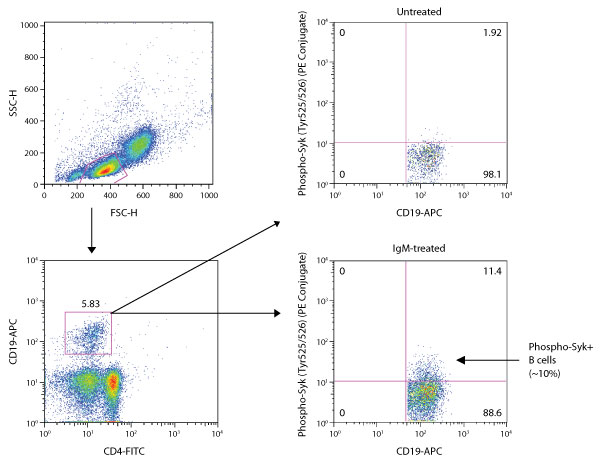Intracellular flow cytometry offers unique advantages to the study of signaling events when compared to western blot analysis. Western blots detect protein levels from a pooled population of cells and therefore may not be sufficiently sensitive to recognize infrequent signaling events, particularly those taking place in a small proportion of specialized cells. This can be misconstrued as a negative result. Owing to its capacity to measure events at a single cell level, flow cytometry allows for the identification of rare signaling events (see example below).


Syk, a non-receptor cytoplasmic tyrosine kinase transmits signals from the B cell receptor (BCR) and is phosphorylated upon BCR activation.
WB was used to study activation of Syk in a PBMC population, which was left either untreated or was treated with IgM (10 μg/ml) for 10 min. Analysis of total Syk by WB using Syk Antibody #2712 reveals two bands of the correct molecular weight for both groups. However, probing for phosphorylated Syk using Phospho-Syk (Tyr525/526) (C87C1) rabbit mAb #2710 yields no visible bands. Syk is only expressed in the B lymphocyte population within the PBMCs, and only a small proportion of B cells will show activation of Syk after treatment. Therefore, the effect of the IgM treatment is diluted within the protein lysate and undetectable when analyzed by WB.
When doing the same analysis by flow cytometry, co-staining with CD19 and CD4, B and T cell-specific markers, respectively, can identify B cells. CD19 positive and CD4 negative B cells can be examined for Syk phosphorylation. As expected, there is no activation of Syk in untreated cells. However about 10% of B cells become positive for phospho-Syk following IgM treatment. Thus flow cytometry, unlike western blotting has the capacity to identify and resolve this small but real sub-population of B lymphocytes from a heterogeneous pool of human PBMCs. .
CyTOF® mass cytometry single cell proteomics platform uses metal conjugated antibodies to simultaneously profile over 30 proteins within a single cell.
Cell Signaling Technology (CST) offers a diverse portfolio of thoroughly validated flow cytometry antibodies in PBS formulation, suitable for use with the CyTOF® mass cytometer.